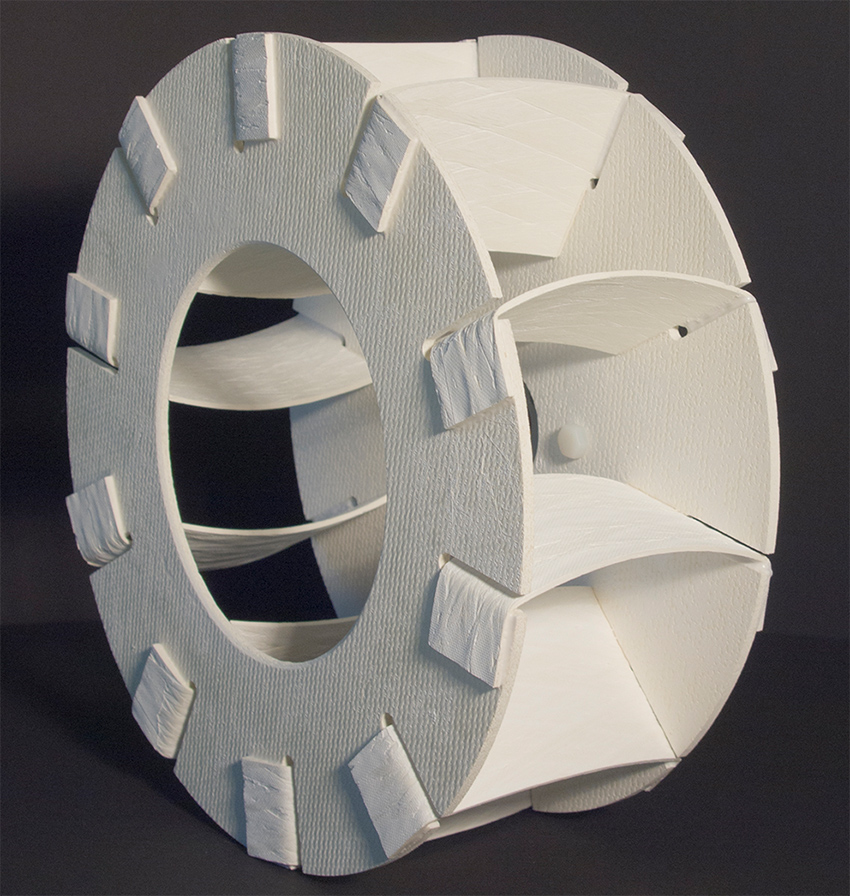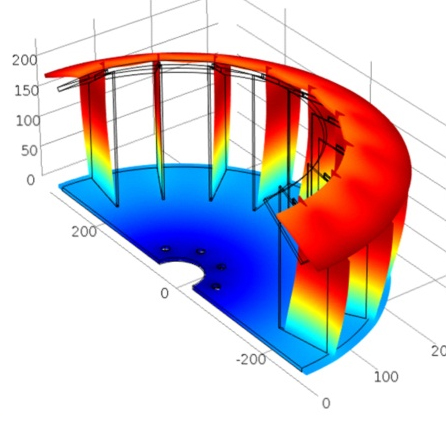At Fraunhofer Center HTL, fiber-reinforced ceramics, so-called Ceramic Matrix Composites (CMCs), are developed. The HTL covers the entire process chain from fiber production, their textile processing, to the construction of the matrix and system integration. It can offer customized solutions at all levels. With the manufacturing facilities, material samples, prototypes, and small series up to pilot scale can be produced.
Ceramic Matrix Composites (CMCs)
The most important properties of CMCs are their high fracture toughness and damage tolerance compared to monolithic ceramics under thermal and mechanical loads. In order to adjust the quasi-ductile properties of the fiber composite materials, various material concepts such as weak interface or weak matrix concepts are applied at the HTL.
At the HTL, non-oxide CMCs such as carbon fiber reinforced SiC (C/SiC) and silicon carbide fiber reinforced SiC (SiC/SiC) as well as oxide fiber reinforced CMCs are developed. Since CMCs can only be used in special applications due to their manufacturing costs, novel low-cost CMCs for the temperature range below 1000°C are also being developed.
The HTL selects suitable starting materials such as fibers, textile structures, and matrices to achieve the desired material properties for material design. Typical reinforcement fibers that are processed include commercial glass, basalt, carbon, aluminum oxide, mullite, and silicon carbide fibers. Ceramic fibers can also be developed from polymer precursors and manufactured up to pilot scale on a customer-specific basis. The fibers are further processed as fiber rovings or textile fiber preforms. Textile processing enables 2D or 3D preforms with a load-bearing arrangement of the fibers. For non-oxide CMCs, carbon precursors and silicon polymers are preferred as matrices, which are converted into ceramics through high-temperature processes. Additionally, carbide matrices are produced using the Liquid Silicon Infiltration (LSI) process (see publication: Fundamental Mechanisms With Reactive Infiltration), in which a liquid silicon melt is infiltrated into porous fiber preforms. In the field of oxide CMCs, matrices based on aqueous suspensions in the Al2O3-SiO2-ZrO2 system are mainly used.
Fiber composite components are produced as prototypes or in small series in closed process chains. Components made of fiber-reinforced ceramics are designed on the computer based on finite element analyses. The component design includes a load-conforming arrangement of the reinforcement fibers. For the production of fiber composite components, pilot plants are available that allow scaling up from laboratory samples to large component dimensions of up to about 1000 mm. A fiber pilot plant is available for scaling up newly developed ceramic fibers, which allows production in ton scale. Fiber preforms are produced with numerous facilities for textile fiber processing at the Center for Textile Fiber Ceramics TFK in Münchberg. For green production, hot presses, a CNC-controlled winding machine, and a continuously operating prepreg system are available. The heat treatment of the fiber-reinforced composite bodies is carried out in different ovens with large usable volumes, including special high-temperature furnaces up to 2400 °C.
For intermediate and final processing of CMC components, a fully automatic 5-axis machining center is available at the HTL. Specifically developed ceramic surface coatings, known as Environmental Barrier Coatings (EBC), can enable CMC components to be used under harsh conditions, such as high temperatures and corrosive atmospheres. Form-fitting and material to material joining techniques are used at the HTL to manufacture complex component geometries from simple CMC semi-finished products or metal-CMC composites. If required, after successful prototype production, the HTL offers a concept for small-scale production of CMC components, which can be supplemented with customer-specific quality assurance measures. Thus, technology transfer to production scale is possible.
At the HTL, numerous non-destructive, mechanical, and thermophysical testing methods are available for the characterization of CMCs. Non-destructive testing methods can be used to analyze the structure and homogeneity of CMC materials and to detect material defects that may occur during manufacturing or use. Mechanical testing can be performed at room temperature and at temperatures up to approximately 1500 °C. A large number of standardized methods (DIN, EN, ISO, ASTM) are available, and both quasi-static and dynamic-cyclic loading profiles, including fatigue tests, can be applied to CMCs. Fiber preforms, samples, and components can be examined using computed tomography and other analysis methods before and after processing or testing to detect any damage or material changes. The corrosion resistance of CMC components is assessed using exposure tests, and the integrity and strength of joining techniques are also tested.
Service Offering:
- Development of oxide-based and non-oxide-based Ceramic Matrix Composites (CMCs)
- Development of Low-Cost-CMCs
- Manufacturing of material samples, prototypes, and small series
- Process optimization
- Tailoring specific material properties through fiber, preform, and matrix development
- Manufacturing of textile ceramic semi-finished products
- Optional surface coatings for corrosive applications (EBC)
- Characterization of Ceramic Matrix Composites (CMCs)
- Determination of material parameters according to standards
 Fraunhofer ISC, Center for High Temperature Materials and Design HTL, Bayreuth
Fraunhofer ISC, Center for High Temperature Materials and Design HTL, Bayreuth

